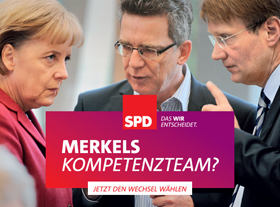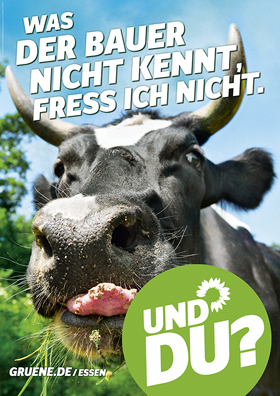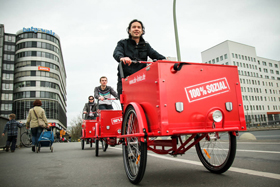Germany: Political Landscape Ahead of Bundestag Elections
Election posters, showing the two top
candidates for next German chancellor at
a street in Duisburg, western Germany,
Thursday, Aug. 29, 2013. Peer Steinbrueck of
the Social Democratic Party, SPD, left, will
challenge German chancellor Angela Merkel of
the governing Christian Social Democrats,
CDU, right.
(no votes) |
(0 votes) |
Ph.D in Economics, Deputy Director of the RAS Institute for Europe, Head of the Country and Regional Researches Department, Head of the German Research Center
On September 22, Germans are headed to the polls to elect the Bundestag, the lower house of the national parliament. The outcome should determine both the parliament's political configuration and the future government coalition that will continue socio-economic reforms in the country and the EU. Analyzing the campaign and candidate activities allows for reasonably accurate forecasting.
On September 22, Germans are headed to the polls to elect the Bundestag, the lower house of the national parliament. The outcome should determine both the parliament's political configuration and the future government coalition that will continue socio-economic reforms in the country and the EU. Analyzing the campaign and candidate activities allows for reasonably accurate forecasting.
The Campaign Specifics
In mid-August, the election campaign to the lower house entered its final stage. Key politicians have been fairly active in various events, primarily numerous meetings held in selected Lands. A poster-and-slogan war also was launched to attract voters guided not by conviction or knowledge of election platforms, but by the likeability and intuitive appeal of candidates. Normally, this part of the electorate (about 30 percent of the total number) arrives at their decisions right before voting.
The intermediate achievements of the leading German parties on the eve of the final election appear relatively modest.
One. No party has presented a platform that outlines an integrated vision for Germany's medium-term development within the changing environment or that suggests a way forward to improve the model of the country’s socially-oriented economy [1]. Wary of losing votes, the parties have been cautious and have aimed their platforms at the paternalist-minded electorate. Mostly, they have focused on fine-tuning traditional approaches, one reason why many experts are calling the campaign boring.
No party has presented a platform that outlines an integrated vision for Germany's medium-term development within the changing environment or that suggests a way forward to improve the model of the country’s socially-oriented economy.
Two. With the exception of Angela Merkel, no other charismatic politician has been able to win over their target groups or attract other sectors of the electorate. Not coincidentally, all of the parties are staking their fates on the support of well-known figures. Whereas the Christian Democratic Union (CDU), which traditionally sides with the Bavarian Christian Social Union (CSU), is working to strengthen the image of Ms. Merkel, the Social Democrats are banking on maintaining the overall popularity of the Social Democratic Party (SDP).
Three. Peer Steinbrueck, the SDP candidate, does not appear to be an equal rival to Ms. Merkel of the CDU/CSU, the current and apparently future chancellor.
Four. No political miracle has taken place, since the star of the Alternative for Germany (AfG), a new party that had stirred up German society, has failed to rise. According to polls, this party has failed to reach the required five-percent margin and will run against the marginal Pirate Party. However, on September 22, the AfG may rob the key parties of up to two percent of the vote by criticizing Berlin's official stand on the Eurozone and approaching the cherished parliamentary threshold.
Five. By mid-August, the parties had neglected critical political and economic issues in favor of attacking their opponents, although with minor effects on electoral opinion.
Six. As of surveys held in mid-August, only 62 percent of voters were ready to go to the polls, with about the same percentage of the group decided on their preferences (68 percent in 2009). There are considerably fewer voters interested in politics and election platforms. While 35 percent of the electorate discussed the elections in 2009, the current share is only 29 percent. However, each party is hoping to attract up to five percent of their former and new voters.
Ms. Merkel does not appear to have obvious successors, and in early August she denied rumors about her possible early resignation in 2016 to confirm a readiness to occupy the chancellor's seat during the next election cycle.
Seven. The campaign is proving that a crisis is taking place within popular parties self-described as occupying the middle of the political spectrum. These parties are decreasing in number [2], with traditional party work in grass-root organizations losing popularity. Nevertheless, minor parties are continuing to develop their new identities by defining themselves in reference to the German and European political coordinate system.
Eight. All parties are striving to put forth innovative ways of attracting voters, primarily through holding Internet discussions, meetings in new formats, etc.
Nine. The Americanization of the campaign is definitely underway, with parties forcefully obstructing the activities of their rivals and using political technologies not exactly spotless by German standards. There have been cases of interference by unidentified groups, for example, violence during an AfG meeting and the massive distribution of fake posters of key parties.
Election Promises
The CDU is ruled possessively by Ms. Merkel, its chairman and head of government, which has caused the party’s campaign approach to be labeled "chancellor democracy". The party's popularity largely hinges on the chancellor's clout inside the party and reputation among Germans. Noticeably, the popularity is invariably resistant to scandals coming from her ministers, permanent attacks from the opposition, and the behavior of her alliance and coalition partners. Ms. Merkel does not appear to have obvious successors, and in early August she denied rumors about her possible early resignation in 2016 to confirm a readiness to occupy the chancellor's seat during the next election cycle. Her election team has a clear-cut campaign plan that she is successfully bringing into life. One of its cornerstones is an offer for an individual contract with every German under which the state pledges to help each person in implementing his or her dream with no obligations on their part. In her first official campaign address in the city of Seligenstadt, Ms. Merkel formulated her message as follows: "Consider our proposals in order to make sure that it is our proposals which are proper".
The key intrigue will focus on the Free Democrats. If they obtain the required five percent, the total with added CDU/CSU votes could exceed 45 percent, which means that the coalition remains.
Prior to the federal election, the Bavarian CSU will be tested at the September 15 Landtag elections. The aim is to restore the status quo lost five years ago and to regain the absolute majority the party enjoyed from 1962 to 2008. Such an outcome would allow the CSU to exit the coalition with the Free Democratic Party in Bavaria, although the party appears unlikely to be able to preserve the existing ruling coalition without its participation at the federal level. Hence, for the time being, Horst Seehofer, the CSU chairman and Minister-President of Bavaria is speaking of continued cooperation with the Free Democrats. The Land elections results will be publicized before the Bundestag vote and should definitely affect its outcome. Party leaders are facing a difficult challenge - avoiding blunders during the campaign’s final stretch and beating their key rivals without inflicting harm to the chances of the Free Democrats during the September 22 elections. This time, the party has received sizeable support from Ms. Merkel who has found the key to the Bavarian electorate. Her speeches, including those in the beer tents – traditional Bavarian campaign locations – deserve inclusion in political science textbooks.
In a nutshell, the CDU/CSU platform entitled "Successful Together for Germany" offers a carrot for everyone, since each voter is able to find something individually attractive, there with the main aim of consolidating the budget and relaxing a stimulus plan for economic growth made at the state's expense. In the first half of 2013, the Free Democratic Party (FDP) successfully overcame negative trends and somewhat restored the trust of its electorate. Beginning in mid-summer, the party has assertively enjoyed support above five-percent. Surveys one month before the elections show that the FDP may go through to the Bundestag, but will obtain almost 3 times fewer seats than it received in 2009 (14.9 percent of the votes and 93 seats) [3]. Ministerial posts would also decrease accordingly, which makes many campaigning deputies unhappy. The leading candidate is Rainer Brüderle, chairman of the parliamentary faction and the party's poster face. Quite a lot will depend on Philipp Rösler, party chairman and vice-chancellor of Germany, as well as foreign minister Guido Westerwelle. A meeting in Kiel is to be held in September and the FDP convention in Mainz will specify the aims of a possible government coalition one week before the electorate goes to the polls.
This time, the Free Democrat's platform (Civil Program: Making Germany Remain Strong) is switching from the image of the "low tax party" to the "the party of prudence and justice in remuneration". They would like to legislatively restrict the share of social and other payments by employers, support individual entrepreneurship, divert additional tax revenues from economic growth exclusively to investments and reducing state debt, and cancel the solidarity bonus by 2019.
The SDP appears to have failed to learn the lesson of the 2009 elections when they were crushed, gaining a meager 23 percent of the vote, the lowest figure in its history [3]. Despite high expectations, no consolidation of forces took place, at least among SDP leaders. Moreover, the party failed to garner adequate operative and organizational support for Mr. Steinbrueck who was running for chancellorship. As a result, this apparently outstanding politician adopted an incorrect campaigning approach and was largely deprived of his deserved popularity. Bickering among party leaders intensified in summer 2013 which hardly improved the SDP's electoral standing.
Social justice has become the leitmotif of the party's program (We are to Solve) and the entire campaign aimed to form a coalition with the Greens. They are offering minimum wages, low taxes for low-income families with children with simultaneous higher taxes for the rich, clear-cut rules for financial markets and the establishment of a supervising body, and the cancellation of paid university education. The SDP has proposed the investment of 80 billion euro into the modernization of infrastructure. According to experts, its criticism of the ruling parties, including the government's energy policy, was not exactly effective, as well as certain posters aimed t pointing out the inefficiency of Ms. Merkel's government. For example, the European UAV failure and American eavesdropping of German citizens were depicted by images of Ms. Merkel, Defense Minister Thomas de Maiziere and Chief of Staff of the German Chancellery Ronald Pofalla with the caption "The competent Merkel's team?" But the message remained misunderstood by most Germans who simply failed to recognize the individuals beside the chancellor. SDP spin doctors also took up a door-to-door approach to send party members and volunteers to visit five million homes [4], but according to some pundits, many Germans have grown wary of house-to-house canvassing.
The Green Party has managed to preserve the popularity it obtained in the past thanks to the Fukushima accident, the government's new energy program, and conflicts over the construction of a railway station in Stuttgart. Their 327-page program (The Time for a Green Change), the largest vis-à-vis other parties, rejects hydrocarbons in favor of a 100-percent switchover to renewable sources by 2030. Not coincidentally, their key slogan is "100-percent Renewable". They also would like to stop large-scale animal husbandry, limit the export of weapons, fight rightwing extremism, and expand social justice in all fields. The party's main candidates are Jürgen Trittin, chairman of the parliamentary group, and Vice President of the Bundestag Katrin Göring-Eckardt.
The Left Party (program "100-Percent Social") relies on social justice slogans and harsh criticism of the ruling coalition, aimed at getting as many seats as possible and retaining its oppositional role. Noticeably, now they do not regard the SDP as their rival as was the case under Oskar Lafontaine, and among other things are appealing to the middle class, i.e. to citizens with a monthly income up to 6,000 euro. The Left have seven candidates to develop each keynote issue, with Gregor Gyzi, chairman of the parliamentary group, appointed the party face and coordinator of all candidates.
Possible Outcomes and Government Coalitions
Although black swan events are probable, the balance should remain basically intact. The key intrigue will focus on the Free Democrats. If they obtain the required five percent, the total with added CDU/CSU votes could exceed 45 percent, which means that the coalition remains. The SDP and the Greens can expect a maximum of 40 percent. At the same time, including Left Party votes, the total might reach 48 percent (for example, 25+15+8), while the current coalition would receive about 43 percent (38+5). In this case, a repeat of the 2005 situation is likely, i.e. a grand SDP-CDU/CSU coalition. However, this time the black-and-green card could be played [5], with the possibility of agreements between the Green Party and the CDU/CSU at least above zero. Theoretically, the red-red-green alliance is also feasible, but the Land-level schemes are hardly likely on the federal level, where matters of principle are much more significant. Should it happen in September 2013, the construction would be stillborn [6].
The most likely scenario suggests the preservation of the current government. Apart from a fairly effective election campaign, the CDU/CSU and FDP can boast economic stability, constant (although slight) GDP growth from 2010, minimum unemployment, and the running consolidation of the national budget.
The most likely scenario suggests the preservation of the current government. Apart from a fairly effective election campaign, the CDU/CSU and FDP can boast economic stability, constant (although slight) GDP growth from 2010, minimum unemployment, and the running consolidation of the national budget. All these make Germans fairly happy, as shown by surveys indicating that on the eve of elections, most do not expect a crisis in Germany or its in the Eurozone, which might bring more lost jobs and lower individual standards of living. Hence, Germans most likely will not seek political changes, with trust in the chancellor running high.
A black-and-red coalition is less likely. As of today, the scenario seems undesirable for its potential participants for political reasons, but quite possible in tactical terms. Moreover, the electorate is sympathetic to such an alliance, regarding it as a factor of stability. Next comes a red-and-green grouping. The least likely and hence potentially sensational scenarios are the possibility of red-green-yellow, black-and-green and red-red-green blocs. In the first case, the chances are the best for the government to proceed with reforms, primarily economic, despite inter- and intra-party differences, especially as new and possibly ambitious ministers are expected to surface. In other scenarios these chances are much lower.
As for foreign policy, the two mostly likely coalitions should go ahead with the forcible neutralization of the Eurozone crisis and European construction with the focus on search of Germany's niche in the world politics. The transatlantic vector is going to be fine-tuned to account for the eavesdropping scandal, although Berlin will continue working on the EU-U.S.A. free trade area. The new leaders will continue developing optimal relationships with China, India, Brazil and Mexico. Ties with Russia are not likely to change, which means gradual progress along all tracks, parallel with harsh criticism of Russia's president and his circle.
1. During the past decade, for various reasons the model of a socially-oriented market economy has given up on the ordoliberal principles laid down by Ludwig Erhard. It can no longer offer an effective and highly competitive environment for economic entities, especially small and medium businesses.
2. German political analyst Oskar von Niedermayer offers the following data on party membership as of late 2012 (in absolute figures, with percentage dynamics against the previous year in brackets): SDP – 477,037 (-2.6%), CDU – 476,347 (-2.8%), CSU – 147,965 (-1.7%), the Left Party – 63,761 (-8.2%), the Green Party – 59,653 (+1.0%), FDP – 58,675 (-7.0%). Except for the Greens, there are losses within all other parties, with even greater drops in compared to 2010 (http://www.spiegel.de/politik/deutschland/bei-mitgliederzahlen-der-parteien-liegt-spd-vor-cdu-a-916899.html).
3. Germany. 2010 / Ed. by V.B.Belov // Reports of the Institute for European Studies. № 267. М.: RAS Institute for European Studies; Russian Souvenir, 2011. Pp. 10–33.
4. The SDP boasts the largest campaign budget of 23 million euro, CDU – 20 million euro, the Greens – 5.5 million euro, the Left – 4.5 million euro, FDP – 4 million euro. However, the SDP lags behind the CDU in billboards (8,000 against 8,700). While small parties focus on their program content, popular parties aim to mobilize their target groups during campaign events (http://www.faz.net/aktuell/politik/bundestagswahl-2013/parteien-werben-wahlkampf-mit-wohlfuehlplakaten-12541295.html).
5. German parliamentary parties traditionally carry the following colors: CDU/CSU – black, FDP – yellow, SDP – red, alliance 90/the Greens – green, the left – red. Accordingly, potential coalitions acquire their gamut.
6. According to some reports, SDP Chairman Sigmar Gabriel counts on a grand coalition. On the one hand, that should remove his colleagues Messrs. Steinmeier and Steinbrueck from the social-democratic Olympus, while on the other, in 2015-2016, the SDP might leave the CDU/CSU coalition and form a government with the Greens and the Left, whose image could become acceptable for the electorate by that time. Then, Mr. Gabriel could become chancellor, which seems quite a likely scenario.
(no votes) |
(0 votes) |







